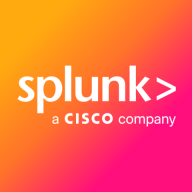

Splunk Observability Cloud and Grafana both compete in the observability and monitoring solutions category. Grafana has an advantage in visual customization and cost-effectiveness, while Splunk is more robust in handling complex environments with its AI-powered analytics.
Features: Splunk Observability Cloud offers log analytics, seamless integration with numerous third-party applications like AWS, and AI-powered analytics for monitoring complex environments. It provides extensive customization for dashboards and reporting tools. Grafana is an open-source platform that connects with multiple data sources, providing detailed visualization capabilities and flexible dashboard customization.
Room for Improvement: Splunk Observability Cloud is often criticized for its high cost and complex setup. Improvements in feature integration, user interface, and better integration with third-party products are needed. Grafana could improve its integration capabilities, expand alerting functionalities, and streamline deployment to offer easier setup for new users.
Ease of Deployment and Customer Service: Splunk Observability Cloud provides choices between on-premises, private, hybrid, and public cloud deployments, with responsive customer service that can occasionally be slow. Grafana, available across various environments, offers flexible deployment options and benefits from robust community support, although it could use more detailed technical support.
Pricing and ROI: Splunk Observability Cloud is known for high pricing suited to large enterprises needing extensive features, while Grafana provides a cost-effective alternative with a free open-source model and affordable enterprise options, delivering substantial value, especially for visualizations.
Using Splunk has saved my organization about 30% of our budget compared to using multiple different monitoring products.
Anyone working in front-end management should recognize the market price to see the true value of end-user monitoring.
I have definitely seen a return on investment with Splunk Observability Cloud, particularly through how fast it has grown and how comfortable other teams are in relying on its outputs for monitoring and observability.
My advice for people who are new to Grafana or considering it is to reach out to the community mainly, as that's the primary benefit of Grafana.
I do not use Grafana's support for technical issues because I have found solutions on Stack Overflow and ChatGPT helps me as well.
I very rarely get in touch with technical support as we don't have that option.
On a scale of 1 to 10, the customer service and technical support deserve a 10.
They have consistently helped us resolve any issues we've encountered.
They often require multiple questions, with five or six emails to get a response.
In terms of our company, the infrastructure is using two availability zones in AWS.
In assessing Grafana's scalability, we started noticing logs missing or metrics not syncing in time.
We've used the solution across more than 250 people, including engineers.
As we are a growing company transitioning all our applications to the cloud, and with the increasing number of cloud-native applications, Splunk Observability Cloud will help us achieve digital resiliency and reduce our mean time to resolution.
I would rate its scalability a nine out of ten.
When something in their dashboard does not work, because it is open source, I am able to find all the relative combinations that people are having, making it much easier for me to fix.
Once you get to a higher load, you need to re-evaluate your architecture and put that into account.
The product has been stable.
I would rate its stability a nine out of ten.
We rarely have problems accessing the dashboard or the page.
Unlike NetScout or regular agents for APM, RUM has many problems during the POC phase because customer environments vary widely.
It would be better if they made the technology easy to use without needing to read extensive documentation.
Grafana cannot be easily embedded into certain applications and offers limited customization options for graphs.
I would want to see improvements, especially in the tracing part, where following different requests between different services could be more powerful.
The out-of-the-box customizable dashboards in Splunk Observability Cloud are very effective in showcasing IT performance to business leaders.
The next release of Splunk Observability Cloud should include a feature that makes it so that when looking at charts and dashboards, and also looking at one environment regardless of the product feature that you're in, APM, infrastructure, RUM, the environment that is chosen in the first location when you sign into Splunk Observability Cloud needs to stay persistent all the way through.
There is room for improvement in the alerting system, which is complicated and has less documentation available.
In an enterprise setting, pricing is reasonable, as many customers use it.
The costs associated with using Grafana are somewhere in the ten thousands because we are able to control the logs in a more efficient way to reduce it.
Splunk is a bit expensive since it charges based on the indexing rate of data.
It is expensive, especially when there are other vendors that offer something similar for much cheaper.
It appears to be expensive compared to competitors.
Users can monitor metrics with greater ease, and the tool aids in quickly identifying issues by providing a visual representation of data.
Its alerting feature is effective because it allows me to set thresholds to send an email if a certain threshold is met.
It's definitely useful for monitoring, alerting, logs, and analysis.
Splunk provides advanced notifications of roadblocks in the application, which helps us to improve and avoid impacts during high-volume days.
For troubleshooting, we can detect problems in seconds, which is particularly helpful for digital teams.
It offers unified visibility for logs, metrics, and traces.
| Product | Market Share (%) |
|---|---|
| Grafana | 3.6% |
| Splunk Observability Cloud | 2.2% |
| Other | 94.2% |


| Company Size | Count |
|---|---|
| Small Business | 13 |
| Midsize Enterprise | 8 |
| Large Enterprise | 24 |
| Company Size | Count |
|---|---|
| Small Business | 20 |
| Midsize Enterprise | 10 |
| Large Enterprise | 46 |
Grafana is an open-source visualization and analytics platform that stands out in the field of monitoring solutions. Grafana is widely recognized for its powerful, easy-to-set-up dashboards and visualizations. Grafana supports integration with a wide array of data sources and tools, including Prometheus, InfluxDB, MySQL, Splunk, and Elasticsearch, enhancing its versatility. Grafana has open-source and cloud options; the open-source version is a good choice for organizations with the resources to manage their infrastructure and want more control over their deployment. The cloud service is a good choice if you want a fully managed solution that is easy to start with and scale.
A key strength of Grafana lies in its ability to explore, visualize, query, and alert on the collected data through operational dashboards. These dashboards are highly customizable and visually appealing, making them a valuable asset for data analysis, performance tracking, trend spotting, and detecting irregularities.
Grafana provides both an open-source solution with an active community and Grafana Cloud, a fully managed and composable observability offering that packages together metrics, logs, and traces with Grafana. The open-source version is licensed under the Affero General Public License version 3.0 (AGPLv3), being free and unlimited. Grafana Cloud and Grafana Enterprise are available for more advanced needs, catering to a wider range of organizational requirements. Grafana offers options for self-managed backend systems or fully managed services via Grafana Cloud. Grafana Cloud extends observability with a wide range of solutions for infrastructure monitoring, IRM, load testing, Kubernetes monitoring, continuous profiling, frontend observability, and more.
The Grafana users we interviewed generally appreciate Grafana's ability to connect with various data sources, its straightforward usability, and its integration capabilities, especially in developer-oriented environments. The platform is noted for its practical alert configurations, ticketing backend integration, and as a powerful tool for developing dashboards. However, some users find a learning curve in the initial setup and mention the need for time investment to customize and leverage Grafana effectively. There are also calls for clearer documentation and simplification of notification alert templates.
In summary, Grafana is a comprehensive solution for data visualization and monitoring, widely used across industries for its versatility, ease of use, and extensive integration options. It suits organizations seeking a customizable and scalable platform for visualizing time-series data from diverse sources. However, users should be prepared for some complexity in setup and customization and may need to invest time in learning and tailoring the system to their specific needs.
Splunk Observability Cloud offers sophisticated log searching, data integration, and customizable dashboards. With rapid deployment and ease of use, this cloud service enhances monitoring capabilities across IT infrastructures for comprehensive end-to-end visibility.
Focused on enhancing performance management and security, Splunk Observability Cloud supports environments through its data visualization and analysis tools. Users appreciate its robust application performance monitoring and troubleshooting insights. However, improvements in integrations, interface customization, scalability, and automation are needed. Users find value in its capabilities for infrastructure and network monitoring, as well as log analytics, albeit cost considerations and better documentation are desired. Enhancements in real-time monitoring and network protection are also noted as areas for development.
What are the key features?In industries, Splunk Observability Cloud is implemented for security management by analyzing logs from detection systems, offering real-time alerts and troubleshooting for cloud-native applications. It is leveraged for machine data analysis, improving infrastructure visibility and supporting network and application performance management efforts.
We monitor all Application Performance Monitoring (APM) and Observability reviews to prevent fraudulent reviews and keep review quality high. We do not post reviews by company employees or direct competitors. We validate each review for authenticity via cross-reference with LinkedIn, and personal follow-up with the reviewer when necessary.